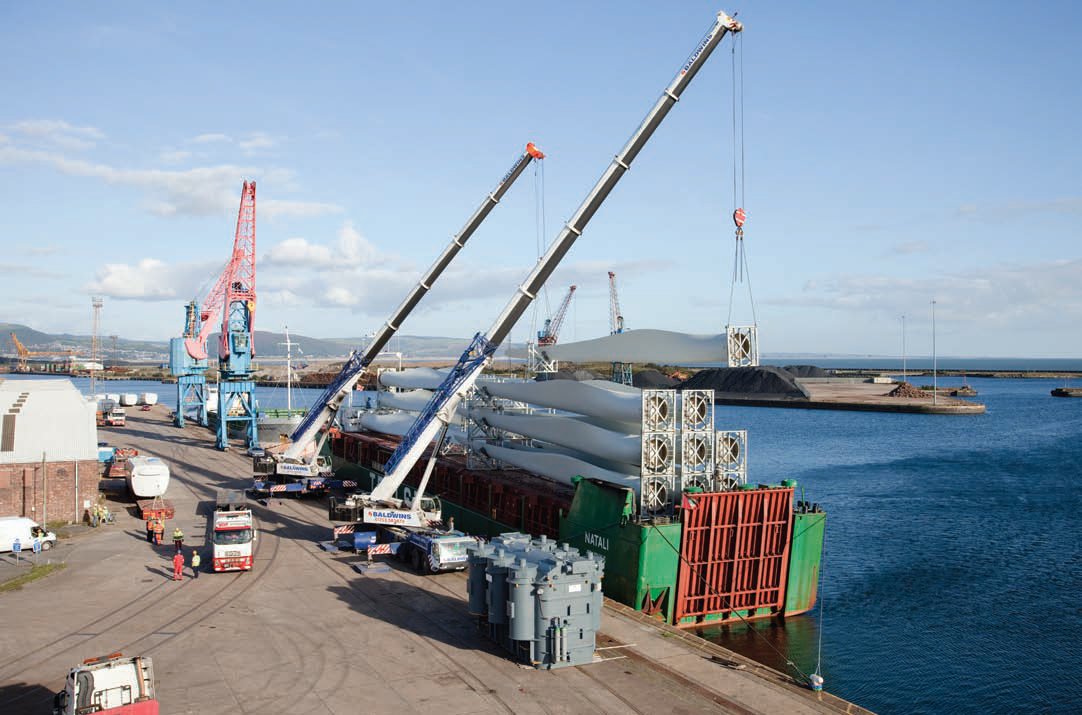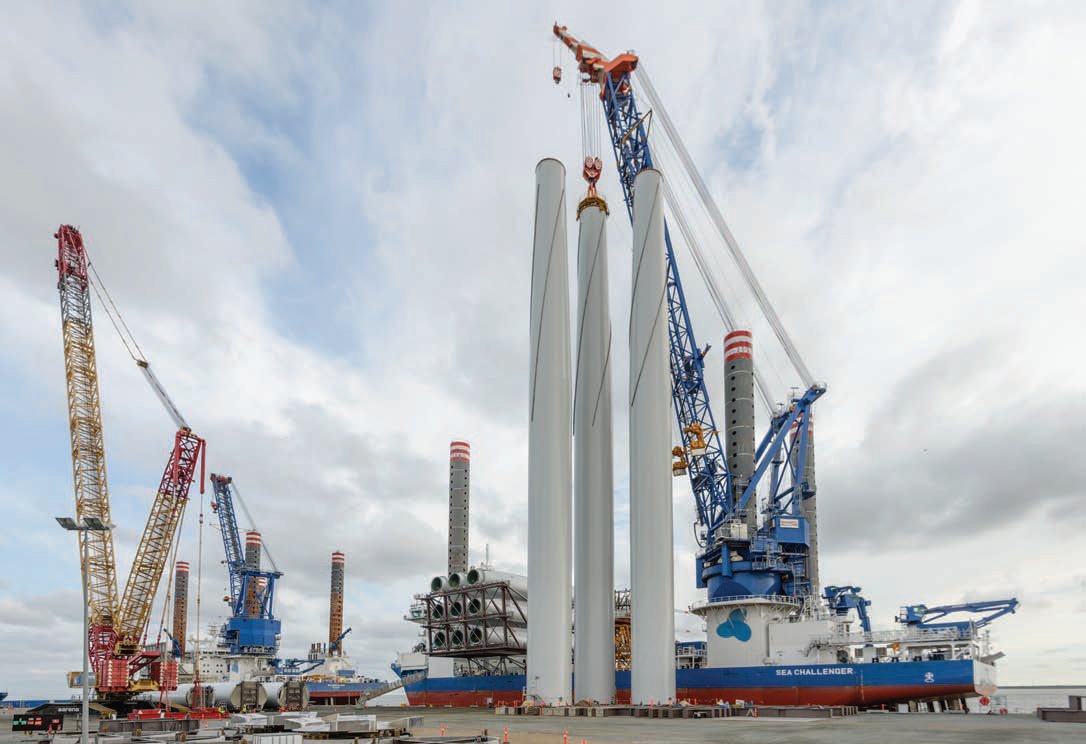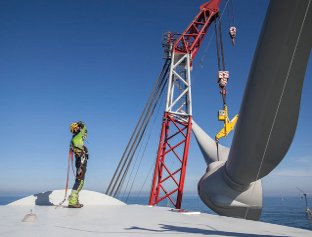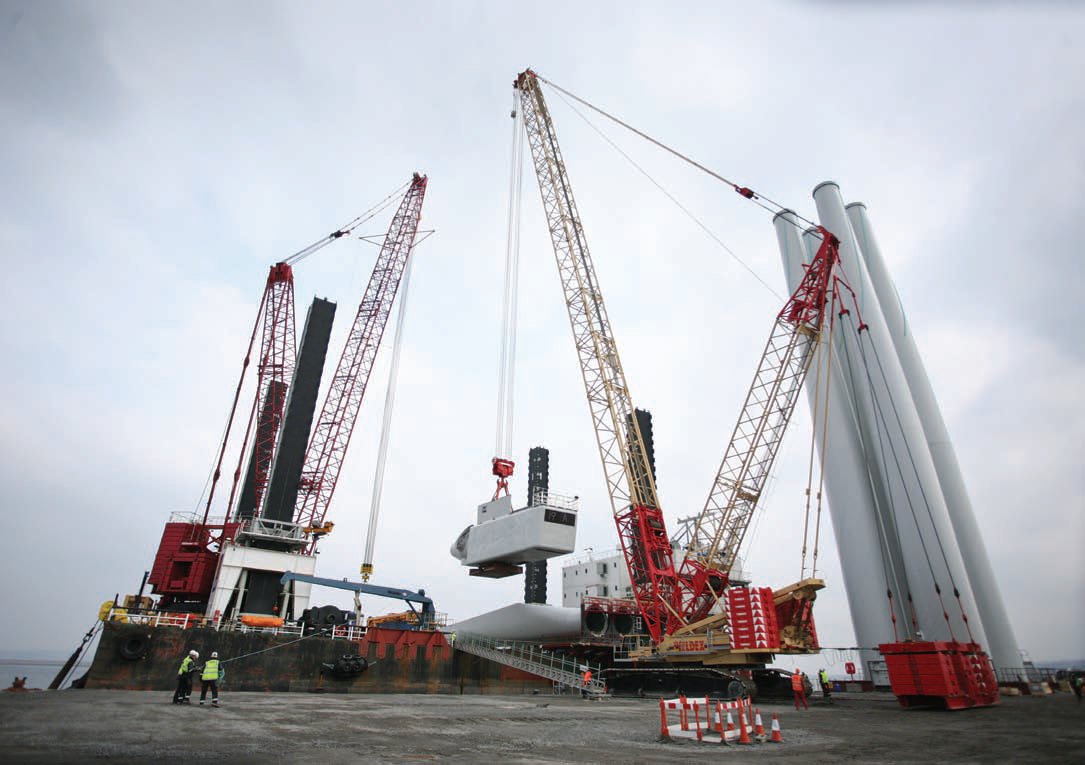Blade handling
28 January 2016Big crawler cranes for versatility and capacity, floating barges and multi-axle transporters are the key tools for a still growing offshore wind sector. Adrian Greeman reports
While flurries of protest can surround hilltop windfarms in the British countryside, the North Sea offshore industry has been growing by leaps and bounds. Projects are getting bigger, both in numbers and the size of the equipment used. Handling needs for the turbines offshore and loading onshore are growing with it, with many ports around the North Sea making largescale investments.
"You are no longer talking about a few windmills in the sea but fullscale facilities that are equal in output to a major power station" says Andrew Ho offshore wind analyst at the European Wind Energy Association.
In total Britain already has 5GW of installed power; Germany brought on line 1.7GW already this year and is aiming for over 6GW by 2020, and France, Holland and Belgium have major projects in hand. Denmark already supplies 39% of its power from the wind. By 2020 Europe as a whole could have 23GW on line says Ho.
"Europe's largest commissioned project, the London Array, generates 630MW" he says, and four recent schemes approved for the Dogger Bank area off the UK, will each have 1.2GW capacity. The Forewind European consortium of four power companies, SSE, RES, Statoil and Statkraft is developing this.
Such schemes involve major construction effort with multiple turbines to erect in a limited time. "Those numbers are reducing but only because generators are getting larger" he says."
Whereas 3-4MW units were typical in the recent past, manufactures now produce much bigger turbines, over 6MW from market leader Siemens in Germany and 8MW from MHI Vestas. Areva also has an 8MW unit and Siemens is itself developing one. Average installed size reported by EWEA for the first half of this year is 4.6MW and typical future contracts like the Danish Dong Energy's Hornsea Project One, sited 120 km off the UK Yorkshire coast and will feature 171 Siemens 7MW turbines, assuming contracts are signed in 2016.
Making and installing units requires substantial heavy lift capacity, both at the factory, at the loading point and at sea. The nacelles for example, the box with the gears, generator and rotor, can weigh over 400t for the latest generation and other parts correspond. Steel towers are a similar weight and the "transition piece" or TP, connecting the tower to its foundations can be 300t.
Blades, while not heavy, are up to 80m long and slender, requiring their own special handling. Special trailers are used with "outriders" and sometimes they transported in an open frame "container" which can be stacked for storage or onto the installation vessel.
And all this could get even bigger. "There are not the limits at sea that face you on land" says Peter Libert, offshore marketing manager at Belgian lifting specialist Sarens Group. "That is for logistical reasons; there are no bridges, tunnels and highway restrictions."
The biggest component is the steel tube for the monopile foundation and these already reach over 1,000t, Scottish lifting company Weldex says. It is tendering for a job currently with 1,100t piles. Sarens is already a very large Terex CC9800 crane with 1600t capacity at the supply end, the EEWfactory in Rostock, which is a market leader for the monopile tubes.
Most wind towers sit on these single piles which are driven into the seabed and then rise up through as much as 40m of water to surface where the TP is attached. The transition adjusts for any lack of verticality in the driven pile and also forms a well-painted and protected area in the sea level splash zone, sometimes with cathodic protection. A steel tower rises above to hold the nacelle and blades.
"There are other foundation types, four or three legged steel jackets, like small versions of oil platforms, fixed by smaller piles into the seabed, and concrete gravity units which simply sit on the seafloor" says Libert. The latter, which can be up to 6,000t, have only been used on one project off France but are planned for another. "They have a role when the seabed is unsuitable for piling" he says.
The challenge, when installing both foundations and the main wind turbine, is not size alone; after all the oil industry handles much bigger things. "It is the logistics of installing so many units efficiently" he says. Delays in placing dozens of units can cost a project its profitability.
The critical element is the offshore vessel which takes the units out to sea, usually driving the piles during one season and returning to fitting the superstructure the next. These are specialist ships operated by firms like A2Sea and Deme Geosea, which have jack-up legs and are fitted with heavy lift cranes.
Liebherr is one crane maker adapting their big crawler cranes for these vessels. The units are assembled at their works in Rostock on the German North Sea coast for fitting onto ships. Liebherr collaborates with marine architects on the vessel design. Capacities have been for 800t but the latest vessels are using up to 1600t cranes.
The resulting ships are expensive to use. "They can cost €100,000 daily or even €300,000 for the biggest, because they come with full complex equipment and technical personnel" says Libert. "The installers and suppliers are very keen to limit the time they are needed therefore and everything pivots around that."
It means supplying the vessels from as close to the offshore site as possible, operating from whichever port location can shave a few costly hours from each journey.
Typically the ships work in approximately two week runs. "We can take out the components for four of the big turbines or eight of the 3.5MW units says Jans Niemann, cranes superintendent at A2Sea. "How long we need depends on the weather windows we get." That once meant summer working primarily, though the latest ships can operate all year round.
Coming back to shore it is important to reload as quickly as possible, working with the ship's own crane to lift components on board, from the quay, though usually using the dockside crawler cranes as well. "So everything must be ready to go" says Libert "which means there must be sufficient stocks in harbour and as far as possible with as much pre-work done as possible." That is the main task for the onshore crawler cranes.
Steel towers are stacked in upright positions so they do not have to be up-ended at sea; if possible the nacelles are pre-fitted with two out of three blades, forming a so-called "bunny" unit with "ears". Elements are positioned quayside. Building up sufficient stock can take time. Production of components chugs along at its own factory pace, often in different locations and cannot be done easily just-intime. "You need to bring everything together at an assembly centre" says Libert "with lots of storage so that a reserve of these big components can be built up". Harbour work therefore involves storing, manipulating and moving the components to quayside at the right moment, which is done usually by firms like Sarens, the UK's ALE, Weldex and Mammoet from the Netherlands among others.
Quite often some of the production facilities may be sited at the harbour too. One of the major examples is at Esbjerg port in Denmark which has been at the forefront for many Danish and German North Sea wind projects projects from early days in 2001. It serves particularly a number of projects in the mid-North Sea off the German coast, and western Denmark.
The port has invested €120M in a "whole new harbour space of 250ha" says port spokesman Jesper Bark. A quayside and hard standing with 40t/m2 bearing capacity allows for cranes up to 1200t capacity to be used.
Esbjerg is also a main base for German manufacturer Siemens, the market leader, competing with other equipment suppliers like MHI Vestas, Alsthom, and Areva. Siemens has a long term lease arrangement with the Danish port with a pre-assembly hall on site for supplying local projects and also for sending components to other arrays. "For example we have sent parts to Mostyn port for Irish Sea projects" says Poul Martin, logistics manager for Siemens.
He explains that the facility serves to bring together components. "Blades are manufactured in southern Denmark and brought here by road for storage on a huge back area" he says. "The nacelles are made in two parts in separate factories in Denmark and then come by sea to Esbjerg where they are joined into one. The most recent 6MW units weigh 450t apiece."
The hall uses normal traversing cranes from Kone for this he says. The finished nacelles are not lifted but go down to the quayside by SPMTs a distance of a few hundred metres where they wait for loading. At the quayside other elements are assembled. "The towers are up-ended from horizontal and are joined to the transition sections to form a unit weighing about 470t and these are stored vertically in a special frame. The 'magazine' has 12 towers at a time which means there are enough there for when the installation vessel comes in."
Most of this lifting is done with large crawler cranes, over 1000t capacity, which are the most flexible for this kind of work. Lifting companies like Mammoet and Sarens are used says Martin, usually on a two or three year term contract. Siemens likes to renegotiate relatively frequently to see what might be new in the market he says. Among the firms working at Esbjerg has been Scottish firm Weldex. It has also worked on a variety of other projects around the North Sea particularly off the UK which is currently the country with the most installed capacity and projects in the pipeline.
Technical manager Brian Hyde explains that typically the firm would be using crawler cranes and using SPMTs for the work.
"We did work for two Irish Sea project for example. First of these was the West of Duddon Sands scheme in the Irish Sea for DONG Energy and ScottishPower Renewables. "For that we worked at Belfast loading the monopile tubes and the upright transitions sections, using one of our Liebherr LR11350s, which is a 12,300t crane. Sarens came in later and were handling the turbines, which were delivered by Siemens slightly along the quay. "The job was done at a purpose built facility" he says. Belfast has invested £50M in a 200,000m2 offshore terminal which was opened in 2013.
A second Weldex project, on the west side of the UK, illustrates the general lifting tasks. This is the Walney Two scheme for which for which Weldex did both lifting for foundations, out of Barrowin- Furness, and for the turbine equipment, which was loaded at Belfast.
"For the piles the fabrication work is done in one of the factories in north Europe, perhaps in Bremmerhaven or Rostock, delivering maybe five a fortnight by barge. We have to lift them out and they are stockpiled until there is a big enough reserve for the installation boat to work continuously.
At Barrow he says the big tubular piles were lifted off the delivery barge with two big Liebherrs 1300t cranes and onto SPMTs and then moved to a storage area with beams to support the ends while the multiaxle self-discharged. For delivery they were picked up by two cranes and loaded onto the SPMTs and taken back to the water's edge. "They plugged the ends and then floated them to site."
Taking the piles in an up-ended position is difficult he says as they are cumbersome and even a 1,300t crane cannot handle them. "The next crane size up is 3,000t and that is very expensive."
Use of SMTPs is typical for wind energy jobs says Russ Jones, offshore general manger for ALE. "We did all the storage at Harwich for the Greater Gabard scheme. As the components came in from Esbjerg we had to move them to store and then bring them back for the loading when the installation vessels came in.
That was a medium size scheme with 42 complete units, including 126 blades, 42 nacelles, bottom and top sections for the towers. For this project ALE devised a clamping frame to allow the tower sections to be moved vertically on the SPMTs, he says. For the storage areas ALE worked with Harwich to adapt their facilities he adds.
A number of other UK ports are currently expanding specifically for the offshore wind sector.
Port operator ABLE is currently developing a specific marine renewables facility for its Humber port, on the Lincolnshire North Sea coast. The ABLE marine energy park will have 1,389m of heavy duty deep water quays and 366.7ha of developable land, it says, "which offer multi-user capacity for manufacture, storage, assembly and deployment of wind turbines". It says the quays have been designed in consultation with the offshore wind industry and are suited to deployment of the latest jack-up installation vessels.
Danish Dong Energy has just signed a Memorandum of Understanding for developing facilities there.
Meanwhile in Hull, to the north a similar facility to Esbjerg is being developed by Siemens at the port's Alexandra Dock. Worth around £310M to be split between Siemens and Associated British Ports, it will include a 39,600m2 factory for manufacture of 75m turbine blades and assembly along with offices. Open and covered areas are included for storage, handling, assembly and testing and a second 12,300m2 building will house service and maintenance of turbines plus parts for pre-assembly. It is the first purpose built facility in the UK. Again the lifting needs are likely to be provided by contract companies like Sarens, Mammoet and Weldex, almost certainly using big crawler cranes.
But while port expansion is going ahead in the UK, there is also potential at other North Sea ports such as Flushing in the Netherlands and others. North German saw considerable development in the past decade at ports like Bremmerhaven and others around the Elbe estuary area, and also the siting of a number of production factories for components. Areva wind employs 300 at its main 5MW production facility for example, with blades made nearby too.
Terminal operator BLG Logistics at Bremmerhaven has used sections of its car handling quays for wind components for projects such as Borkum and NorSee Ost, says spokeswoman Annette Schimmel, revamping an area of quay to handle the loads, mostly loaded SPMTs and with the transport vessels using their own cranes. Currently there is no wind operations underway but the port now has capacity and further projects developing. It is also looking at plans to develop a storage and quay facility at Labradorhaven some 10km away, which would allow local factories to load and move components which currently are blocked by a river lock .
Another operator at the port, Eurogate has used part of its large container terminal for wind farm components. Spokesman Friedrich Stuhrmann says that the operator gave over some 175 000m2 of space for up to 6mW nacelles and three legged jacket foundations standing up to 60m high, weighing 600t, again mostly moved by SPMT. "We also used Liebherr crawler cranes to move the nacelles, which weighted 350t."
Another port in the area is Cuxhaven which was used by a manufacturer of tripod jackets, BARD which has since ceased production. The firm installed a dedicated 600t capacity portal gantry crane for the work, running on tracks either side of a 42m wide vessel berthing area; it is still in the harbour which is trying to sell it.
But Cuxhaven is about to get a major investment with the mid- August announcement by Siemens that it is setting up a new assembly facility there for 7MW nacelles.
The €200M plant will employ 1000 people and is"located directly at the edge of Cuxhaven's well-developed harbour, allowing heavy components to be loaded directly onto vessels" it says.
Siemens and others have also been looking to the Us and tinternational markets though they have not taken off yet. "The North Sea has been the ideal location because it is shallow water, near major industrial countries and with a strong "green ethos" suggests Libert.
But there have been schemes mooted for the US, notably the Cape wind project, near Cape Cod and Martha's Vineyard, delayed at present because of finance problems, and various other locations. China and south-east Asia are also potentials.
"And beyond that is deep water wind energy, using floating pontoons and similar technology" believes Libert. Some test rigs have been run, off Sweden for example, but it could be a while before anything happens commercially.




